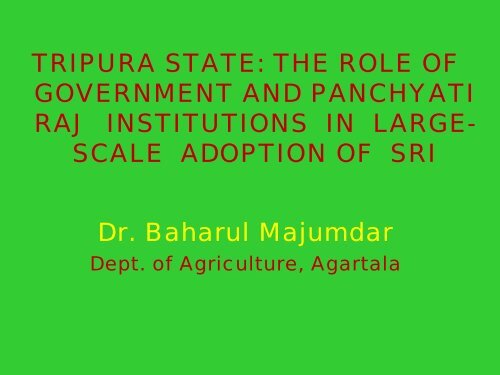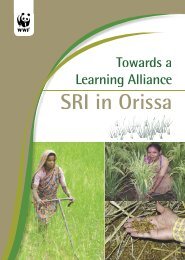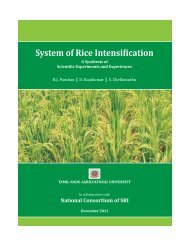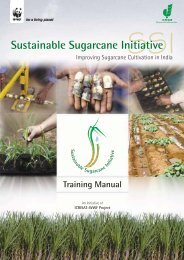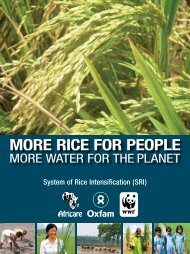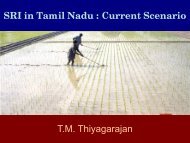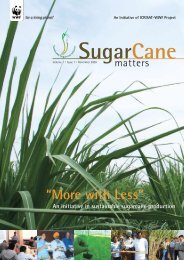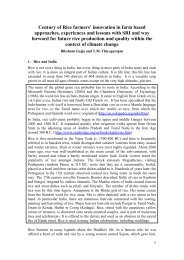TRIPURA STATE: THE ROLE OF GOVERNMENT AND ... - SRI - India
TRIPURA STATE: THE ROLE OF GOVERNMENT AND ... - SRI - India
TRIPURA STATE: THE ROLE OF GOVERNMENT AND ... - SRI - India
You also want an ePaper? Increase the reach of your titles
YUMPU automatically turns print PDFs into web optimized ePapers that Google loves.
<strong>TRIPURA</strong> <strong>STATE</strong>: <strong>THE</strong> <strong>ROLE</strong> <strong>OF</strong><br />
<strong>GOVERNMENT</strong> <strong>AND</strong> PANCHYATI<br />
RAJ INSTITUTIONS IN LARGE-<br />
SCALE ADOPTION <strong>OF</strong> <strong>SRI</strong><br />
Dr. Baharul Majumdar<br />
Dept. of Agriculture, Agartala
WELCOME<br />
To<br />
<strong>TRIPURA</strong>
Distances (in km)<br />
Kolkata 1,645<br />
Guwahati 587<br />
New Delhi 2,637<br />
Shillong 487<br />
Distance to sea (from Sabroom) – 60 km<br />
3
Geographical Location<br />
Kolkata<br />
Agartala-Kolkata distance went from 350 km before Partition, to 1,645 km<br />
4
Brief Profile<br />
Union Territory on 1 st July, 1953; State<br />
from 21 st January, 1972 → 3 rd smallest<br />
<strong>India</strong>n State, after Goa and Sikkim<br />
Long international border (856 km)<br />
Forest land: officially 60% of total area<br />
4 Districts, 17 Sub-Divisions, 40 Blocks,<br />
and 1 Autonomous District Council<br />
Princely State merged in October, 1949<br />
4 Zilla Parishads, 513 Gram Panchayats,<br />
527 ADC Villages, 1 Municipal Council,<br />
and 12 Nagar Panchayats<br />
5
PERSPECTIVE PLAN:<br />
OBJECTIVES 2001-10<br />
10<br />
State Government commitments:<br />
‣ Self-sufficiency in food grains<br />
‣ Improvement in farmers’<br />
economic condition
PERSPECTIVE PLAN IMPLEMENTATION<br />
• After 7 years of implementation of the<br />
Perspective Plan, food grain production up<br />
only from 5.13 lakh tons to 6.35 lakh tons<br />
• There remained a shortfall in foodgrains<br />
of about 1.50 ~ 1.60 lakh tons<br />
• Growth in food grain production cannot<br />
be achieved without adoption of proper<br />
system for improvement of crop<br />
management<br />
• Advent of <strong>SRI</strong> in 2005 came at right time
Shrinkage in Cultivable Area<br />
Diversion of agricultural land<br />
for non-agricultural purposes, i.e.,<br />
• Domestic and other developmental<br />
uses<br />
• Area for fencing along border<br />
• Road construction<br />
• Brick kilns<br />
• Plantation crops like rubber, etc.
Rice is the growth engine<br />
of the State’s economy<br />
Two-pronged strategy was adopted to<br />
increase the rice production per unit<br />
land per unit time<br />
• Crop management – through <strong>SRI</strong><br />
• Varietal technology – hybrid rice
Category of Farmer<br />
Category<br />
No. of farmers<br />
Marginal (< 1 ha) 405,788<br />
Small (1 to 2 ha) 54,598<br />
Semi Medium (2- 4 ha) 17,032<br />
Medium (4 - 10 ha) 1,803<br />
Large (> 10 ha) 207<br />
Total 479,428
Operational Holdings<br />
Farmers<br />
Marginal<br />
(Below 1 Ha)<br />
Small (1 to 2<br />
Ha)<br />
Semi Medium<br />
(2-4 ha)<br />
Operational<br />
holdings (%)<br />
<strong>TRIPURA</strong><br />
ALL-<br />
INDIA<br />
Area operated<br />
(%)<br />
<strong>TRIPURA</strong><br />
ALL-<br />
INDIA<br />
Average size of<br />
holding (ha)<br />
<strong>TRIPURA</strong><br />
ALL-<br />
INDIA<br />
84.6% 63% 47% 19% 0.3 0.40<br />
11.4% 19% 28% 20% 1.4 1.41<br />
3.6% 12% 16% 24% 2.6 2.72<br />
Medium ( 4 - 10<br />
Ha)<br />
Large (above<br />
10 ha)<br />
0.4% 5% 3% 24% 5.2 5.80<br />
0.04% 1% 6% 13% 78.8 17.18<br />
Total 100% 100% 100% 100% 0.56 1.32
ORGANISATIONAL SET-UP<br />
DEPARTMENT <strong>OF</strong> AGRICULTURE<br />
MINISTER <strong>OF</strong> AGRICULTURE<br />
PRINCIPLE SECRETERY <strong>OF</strong> AGRICULTURE<br />
DIRECTOR<br />
<strong>STATE</strong> L<strong>AND</strong> USE BOARD (SLUB)<br />
JDA<br />
(Plan)<br />
I/C<br />
Plann-<br />
Ing<br />
Section<br />
JDA<br />
(PP)<br />
I/C<br />
Plant<br />
Protection<br />
Section<br />
DDA<br />
(Seed)<br />
I/C Crop<br />
Section<br />
DDA (S &<br />
QC)<br />
I/C Ferti. &<br />
Estt. Section<br />
(Gazetted)<br />
DIRECTOR <strong>OF</strong> AGRICULTURE<br />
DDA<br />
(Estt.)<br />
I/C<br />
Section<br />
(Non-<br />
Gazetted)<br />
DDA<br />
(Trainin<br />
g) I/C<br />
Trainin<br />
g &<br />
Develo<br />
pment<br />
DDA<br />
(Market<br />
ing)<br />
I/C<br />
Marketi<br />
ng<br />
Section<br />
DIRECTOR <strong>OF</strong> HORTICULTURE<br />
<strong>AND</strong> SOIL CONSERVATION<br />
Credit<br />
Plannin<br />
g<br />
Officer<br />
I/C<br />
Statisti<br />
cal<br />
Section<br />
Senior<br />
Agrono<br />
mist I/C<br />
Agri.<br />
Researc<br />
h Wing,<br />
A.I. Unit<br />
Principal<br />
I/C<br />
Upgraded<br />
Gram<br />
Sevak<br />
Training<br />
Centre<br />
DISTRICT LEVEL<br />
Agri. Sub-Division Level<br />
(Coterminous with Block)<br />
Agricultural<br />
Farm<br />
(Total 21<br />
Nos.)<br />
West = 5<br />
South = 8<br />
North= 3<br />
Dhalai =5<br />
Dy. Director of Agriculture I/C/ of respective Districts (Total 4 – Districts)<br />
Circle V.L.Ws I/C<br />
V.L.W.Circle<br />
Total = 704<br />
West = 265<br />
South = 208<br />
North = 138,Dhalai = 93<br />
Superintendent of Agriculture, I/C Agri. Sub Division (Total 20 Nos.)<br />
Agriculture Sector Officer, I/C Sector (Agri) (Total = 78 Nos.)<br />
V.L.W. Store, I/C Input Stores<br />
West = 158 Nos.<br />
South = 106 Nos.<br />
North = 72 Nos.<br />
Dhalai = 41 Nos.<br />
Power Tiller<br />
Hiring Centre<br />
West = 35<br />
South = 26<br />
North = 12<br />
Dhalai = 7<br />
W. Tripura = 1<br />
S. Tripura=1<br />
N. Tripura=1<br />
Dhalai = 1<br />
W Dist = 8<br />
S Dist = 5<br />
N Dist = 4<br />
Dhalai Dist =3
Institutional approach for<br />
Promotion of <strong>SRI</strong> – 2002-06<br />
<strong>SRI</strong><br />
Department of Agriculture<br />
DISTRICT<br />
4 no<br />
AGRI SECTOR<br />
78 no<br />
VILLAGE LEVEL CIRCLE<br />
1040 no<br />
SUB DIVISION<br />
22 no<br />
FARMERS FIELD
Experimental Demonstration<br />
Experimental Demonstration in the<br />
farmers field taken up from the crop<br />
year 2002-2003- Kharif Season<br />
• 2002-03 – 44 no -@ 0.2 ha<br />
• 2003-04 – 88 no @ 0.2 ha<br />
• 2004-05 – 440 no @ 0.4 ha<br />
• 2005-06 – 880 no @ 0.4 ha
• Criticism<br />
• Resistance<br />
• Opposition
Visit of Mrs. Radha Singh, IAS,<br />
Former Secretary. MOA, GOI
Visit of Dr. M.S. Swaminathan
MASS MOVEMENT<br />
<strong>SRI</strong> MOVEMENT
RECASTED INSTITUTIONAL APPROACH<br />
PANCHAYAT<br />
DEPARTMENT<br />
Department of Agriculture TRIBAL WELFARE DEPARTMENT<br />
DIRECTOR <strong>OF</strong> PANCHAYAT<br />
DIRECTORATE <strong>OF</strong> TRIBAL WELFARE<br />
PRI<br />
TTAADC<br />
527 NO Village Council<br />
WEST ZILA<br />
PARISHAD<br />
SOUTH ZILA<br />
PARISHAD<br />
DHALAI ZILA<br />
PARISHAD<br />
NORTH ZILA<br />
PARISHAD<br />
PANCHAYAT<br />
SAMITI<br />
PANCHAYAT<br />
SAMITI<br />
Total = 23 Nos.<br />
PANCHAYAT<br />
SAMITI<br />
PANCHAYAT<br />
SAMITI<br />
GRAM<br />
PANCHAYAT<br />
GRAM<br />
PANCHAYAT<br />
Total = 513 Nos.<br />
GRAM<br />
PANCHAYAT<br />
GRAM<br />
PANCHAYAT
Awareness Cum Training -<br />
Public Representatives<br />
• Future Food Crisis<br />
• Future water Crisis<br />
• What is <strong>SRI</strong><br />
• Why it is essential<br />
• How to Practice it<br />
• How to Adopt it<br />
• Incentive of <strong>SRI</strong><br />
• Problem relates to practice and adoption of<br />
<strong>SRI</strong><br />
• How to minimize problems<br />
• Incentive for <strong>SRI</strong> adoption
Large Scale Adoption of <strong>SRI</strong><br />
AGRI<br />
DEPTT<br />
<strong>SRI</strong><br />
PRI<br />
TTAADC
PRI’s / TTAADC Contribution<br />
• Farmers Mobilization<br />
• Weeder<br />
• Marker<br />
• Labour Cost – 20 – 25 mandays<br />
• Drainage and Irrigation Channel
FINANCIAL BREAK UP <strong>OF</strong> <strong>SRI</strong> DEMONSTRATION:<br />
Sl<br />
Physical<br />
Financial (In Rs)<br />
No.<br />
Item/Input<br />
Per ha in<br />
Kg/ No<br />
Per 0.2 ha<br />
unit area<br />
Per ha in<br />
Kg/ No<br />
Per 0.2 ha<br />
unit area<br />
1 Seed (Kg) 5 1 70.0 14.0<br />
2 N:P:K @ 20:10:10 kg/ ha<br />
a) Urea<br />
44<br />
9<br />
230.0<br />
46.0<br />
b) SSP<br />
63<br />
13<br />
330.0<br />
66.0<br />
c) MOP<br />
17<br />
4<br />
89.0<br />
18.0<br />
3 Organic Manure 10 2 2500.0 500.0<br />
4 Bio-Fertilizer @ 4.0 Kg/ha per<br />
cultivator per strain-3 strain<br />
12 2.4 360.0 72<br />
5 Plant Protection Chemicals:<br />
a) Prophylactic<br />
LS<br />
LS<br />
200.0<br />
40.0<br />
b) Bio- agent<br />
LS<br />
LS<br />
150.0<br />
30.0<br />
6 Nursery Materials LS LS 500.0 100.0<br />
7 Contingency Expenditure LS LS 71.0 14.0<br />
Total 4500.0 900.0
Funding Pattern :<br />
• Demo. Cost per Hectare : Rs. 4500.00<br />
• From State Plan : Rs. 2000.00<br />
• From Macro Management: Rs. 2500.00
Rate of Adoption of <strong>SRI</strong> in Tripura<br />
YEAR<br />
Area<br />
covered<br />
through<br />
<strong>SRI</strong> (ha)<br />
Total<br />
paddy<br />
area (ha)<br />
Covered<br />
through<br />
<strong>SRI</strong> (%)<br />
Farmers<br />
involved<br />
(no.)<br />
2002-03 8.8 239,670 0.003 44<br />
2003-04 17.6 242,110 0.007 88<br />
2004-05 176 238,950 0.07 440<br />
2005-06 352 237,150 0.14 880<br />
2006-07 14,678 235,272 6.23 73,390<br />
2007-08 32,497 235,938 13.77 162,485<br />
2008-09 50,000 235,500 21.23 250,000
Rate of <strong>SRI</strong> Adoption in Tripura<br />
Year<br />
2006-<br />
07<br />
2007-<br />
08<br />
2008-<br />
09<br />
Area<br />
Covered<br />
through<br />
<strong>SRI</strong><br />
Total<br />
area<br />
under<br />
paddy<br />
Percent<br />
covered<br />
through<br />
<strong>SRI</strong> (%)<br />
No. of<br />
farmers<br />
involved<br />
14,678 ha 235,272 6.23 % 73,390<br />
32,497 ha 235,938 13.77% 162,485<br />
24,782 ha<br />
(Kharif only)<br />
192,000 12.90%<br />
(Kharif only)<br />
123,910<br />
(Kharif only)<br />
Total <strong>SRI</strong> target for 2008-09 is 50,000 ha<br />
Achievement shown is only for Kharif Season 2008
Productivity of Rice – Tripura vs. All-<strong>India</strong><br />
Year<br />
Yield (tons/ha)<br />
All-<strong>India</strong> Tripura <strong>SRI</strong> in<br />
Tripura<br />
Increase<br />
over<br />
present<br />
practice<br />
2003-04 2.077 2.396 5.360 2.964<br />
2004-05 1.984 2.352 5.025 2.673<br />
2005-06 2.102 2.383 4.690 2.307<br />
2006-07 2.084 2.503 4.271 1.768<br />
2007-08 N.A. 2.550 4.321 1.771
Increase in foodgrains production<br />
through adoption of <strong>SRI</strong><br />
Year<br />
Projected<br />
foodgrains<br />
requirement<br />
Likely<br />
production<br />
with present<br />
trend<br />
Additional<br />
production<br />
through<br />
adoption of<br />
<strong>SRI</strong><br />
in Lakh tons<br />
Projected<br />
production<br />
2008-09<br />
8.09 6.74 0.50 7.24<br />
2009-10<br />
8.22 6.88 0.75 7.63<br />
2010-11<br />
8.34 7.03 0.90 7.93<br />
2011-12<br />
8.48 7.17 1.00 8.17<br />
Per ha average yield increase through <strong>SRI</strong> – 1 Mt


